Themed collection Tin Collection – a celebration of our 10th anniversary

Current advances in tin cluster chemistry
Clusters containing tin atoms show a huge variety of molecular structures, chemical as well as physical properties.
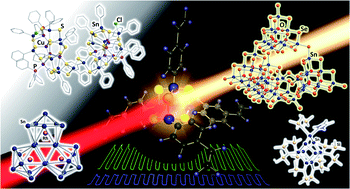
Chem. Sci., 2020,11, 16-26
https://doi.org/10.1039/C9SC04363B
Redox, transmetalation, and stacking properties of tetrathiafulvalene-2,3,6,7-tetrathiolate bridged tin, nickel, and palladium compounds
Capping TTFtt enables facile transmetalation in three different oxidation states.
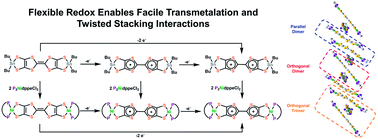
Chem. Sci., 2020,11, 1066-1078
https://doi.org/10.1039/C9SC04381K
Tuning the bandgap of Cs2AgBiBr6 through dilute tin alloying
Sn alloying tunes a halide double perovskite to absorb visible light, in a nontoxic composition.

Chem. Sci., 2019,10, 10620-10628
https://doi.org/10.1039/C9SC02581B
Assembly of high-nuclearity Sn26, Sn34-oxo clusters: solvent strategies and inorganic Sn incorporation
Unprecedented tin-oxo clusters with record high-nuclearities and electrocatalytic CO2 reduction applications have been prepared via solvent dependent assembly strategies.
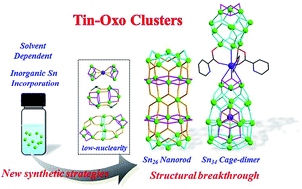
Chem. Sci., 2019,10, 9125-9129
https://doi.org/10.1039/C9SC02503K
Aqueous acid-based synthesis of lead-free tin halide perovskites with near-unity photoluminescence quantum efficiency
Aqueous acid-based synthesis of lead-free tin halide perovskites with near-unity photoluminescence quantum efficiency and high chemical yield is described.
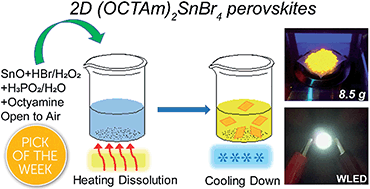
Chem. Sci., 2019,10, 4573-4579
https://doi.org/10.1039/C9SC00453J
Synthesis and structure of a family of rhodium polystannide clusters [Rh@Sn10]3–, [Rh@Sn12]3–, [Rh2@Sn17]6– and the first triply-fused stannide, [Rh3@Sn24]5–
Triply fused cluster: edge shared of three [Rh@Sn10] subunits lead to the largest endohedral polystannide with an entirely new triply fused topology.
![Graphical abstract: Synthesis and structure of a family of rhodium polystannide clusters [Rh@Sn10]3–, [Rh@Sn12]3–, [Rh2@Sn17]6– and the first triply-fused stannide, [Rh3@Sn24]5–](/en/Image/Get?imageInfo.ImageType=GA&imageInfo.ImageIdentifier.ManuscriptID=C8SC03948H&imageInfo.ImageIdentifier.Year=2019)
Chem. Sci., 2019,10, 4394-4401
https://doi.org/10.1039/C8SC03948H
A2SrMIVS4 (A = Li, Na; MIV = Ge, Sn) concurrently exhibiting wide bandgaps and good nonlinear optical responses as new potential infrared nonlinear optical materials
A series of A2SrMIVS4 compounds concurrently exhibiting wide bandgaps and good NLO responses were proven as promising IR NLO materials.
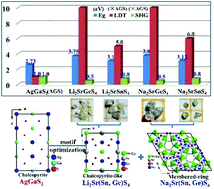
Chem. Sci., 2019,10, 3963-3968
https://doi.org/10.1039/C9SC00028C
Synthetic 2-D lead tin sulfide nanosheets with tuneable optoelectronic properties from a potentially scalable reaction pathway
Thermolysis of molecular precursors followed by liquid phase exfoliation accesses 2-D IV–VI semiconductor nanomaterials.
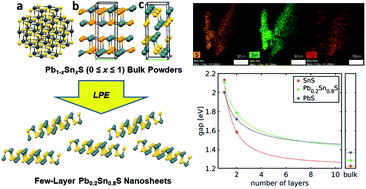
Chem. Sci., 2019,10, 1035-1045
https://doi.org/10.1039/C8SC04018D
Base-induced reversible H2 addition to a single Sn(II) centre
A ‘frustrated Lewis pair’-type mechanism allows the first observation of reversible H2 addition to a single-site main-group complex.
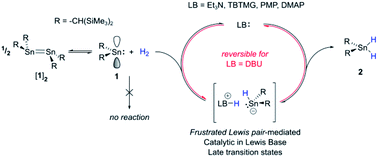
Chem. Sci., 2018,9, 8716-8722
https://doi.org/10.1039/C8SC03110J
Phosphorus doped SnO2 thin films for transparent conducting oxide applications: synthesis, optoelectronic properties and computational models
Phosphorus doped tin(IV) oxide (P:SnO2) films, with resistivity values of 7.27 × 10−4 Ω cm and improved visible light transmission, have been synthesised by AACVD.

Chem. Sci., 2018,9, 7968-7980
https://doi.org/10.1039/C8SC02152J
Boosting the thermoelectric performance of p-type heavily Cu-doped polycrystalline SnSe via inducing intensive crystal imperfections and defect phonon scattering
In this study, we, for the first time, report a high Cu solubility of 11.8% in single crystal SnSe microbelts synthesized via a facile solvothermal route.
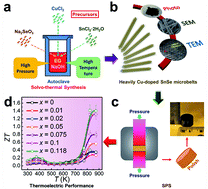
Chem. Sci., 2018,9, 7376-7389
https://doi.org/10.1039/C8SC02397B
Thermodynamic and reactivity studies of a tin corrole–cobalt porphyrin heterobimetallic complex
A rare tin–cobalt bond dissociates homolytically with accurately measured energetics, reversibly releasing a four-coordinate tin radical that catalyzes alkyne trimerization.
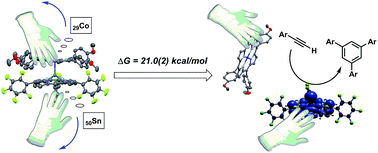
Chem. Sci., 2018,9, 4999-5007
https://doi.org/10.1039/C8SC01269E
Topotactic anion-exchange in thermoelectric nanostructured layered tin chalcogenides with reduced selenium content
Topotactic solution synthesis yields nanostructured tin chalcogenides, SnS1−xSex with controllable composition; spark plasma sintered SnS0.1Se0.9 achieves ZT ≈ 1.16 at 923 K via microstructural texture tuning.

Chem. Sci., 2018,9, 3828-3836
https://doi.org/10.1039/C7SC05190E
About this collection
In the UK, the traditional anniversary gift for a 10th anniversary is Tin. Therefore, to celebrate our 10th anniversary we have collected together some recent articles on Tin chemistry, including a Perspective on current advances in tin cluster chemistry.
We hope you enjoy reading this interesting collection on Tin chemistry!